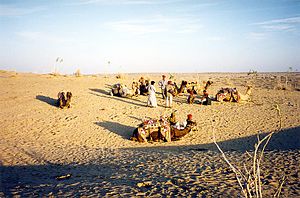|
تضامنًا مع حق الشعب الفلسطيني |
صحراء طهار
صحراء طهار |

صحراء طهار أو صحراء الهند الكبرى هي مساحة صحراوية تجاوز 200 ألف كيلو متر مربع وتقع إلى شمال غرب شبه القارة الهندية وتغطي كل من الهند وباكستان وهي سابع أكبر صحاري العالم وتمتد من جنوب إقليم البنجاب الهندية مرورا بإقليم راجستان وقوجرات إلى إقليم السند في باكستان وتجاورها صحراء كولستان.[1][2][3]
يحدها من الشمال نهر ومن الشرق جبال أرفلي ومن الجنوب بمستنقع ملحي (سبخة) يسمى رانكتش يعده البعض من ضمن الصحراء ومن الغرب نهر السند وتتخلل الصحراء بعض التلال والسبخات والبحيرات كما يعبر نهر لوني، وأثناء الأبحاث الجيولوجية وجد بها بعض عظام الديناصورات التي تعود إلى قبل نحو 300 مليون سنة.
مراجع
- ^ Arisar، Allah Bux (6 أكتوبر 2015). "Families separated by Pak-India border yearn to see their loved ones". News Lens Pakistan. مؤرشف من الأصل في 2016-12-25. اطلع عليه بتاريخ 2016-12-25.
Another woman, Amnat, a resident of Umerkot had a similar story to tell. She was married at the age of 17 and her husband took her to Pakistan. She is presently 60 years old. Her husband passed away 23 years ago. "My father Abdul Karim had also migrated from Rajasthan, India to Umerkot". One of reasons is that his daughter lives in Sindh. Her father narrated to her that at the time of Pak-India wars, Muslims in the border's districts were robbed, killed and harassed by the Indian army, hence he preferred to migrate to a Muslim country like Pakistan to avoid confrontation. She recalled that in the 1965 War between Pakistan and India; Kaprao, Konro, Boath, Vauri, Gahrr jo Tarr, Dedohar, Mate ka Talha, Bijhrar, and a number of other border villages were evacuated. Four persons were killed in the village of Kaprao by the Indian Army based on the allegations that they had been helping the Pakistan Army.
- ^ Raza، Hassan (5 مارس 2012). "Mithi: Where a Hindu fasts and a Muslim does not slaughter cows". Dawn. مؤرشف من الأصل في 2018-06-12.
A Muslim resident of Thar shared his account by saying: "In our village, Hindus and Muslims have been living together for decades and there has not been a single day, when I have seen a religious conflict. No loud speaker is used for Azaan at the time when Hindus are worshiping in their temple, and no bells are rung when it is time for namaz. Nobody eats in public when it is Ramazan and Holi is played by every member of the village." I had always heard stories about interfaith harmony from Sindh but it was so much more amazing to see it firsthand. The love and brotherhood that exists between the Hindus and Muslims of Mithi is a perfect example of pluralism and the tolerant Sufi culture of Sindh.
- ^ Deserts and Desert Environments. John Wiley & Sons. نسخة محفوظة 02 أبريل 2016 على موقع واي باك مشين.
| في كومنز صور وملفات عن: صحراء طهار |